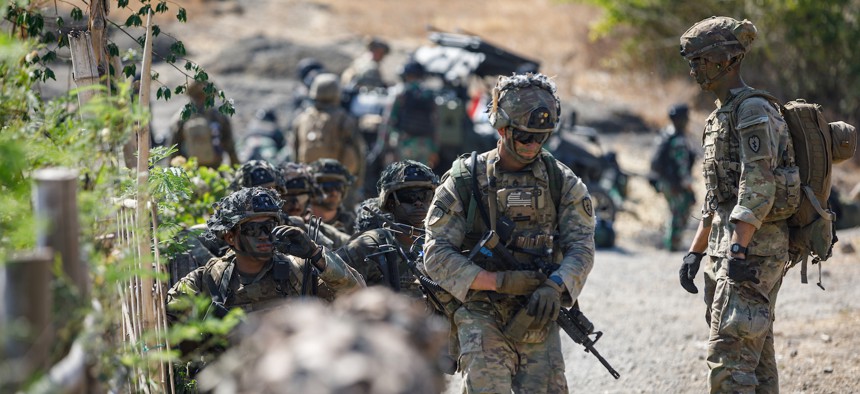
Soldiers with Cold Steele Company, 1-27 Battalion, 2nd Infantry Brigade, participate in the Combined Arms Live Fire Exercise while supporting Super Garuda Shield 2023, at the 5th Marine Combat Training Center in Indonesia., Sept. 11, 2023. U.S. Army / Staff Sgt. Keith Thornburgh
US partners in Asia can act as ‘counterweight’ to China, says Army Pacific commander
“Each of these nations out here are working to defend their national sovereignty,” Gen. Charles Flynn said Wednesday.
About a dozen countries are participating in more than 40 exercises with the U.S. military across the Indo-Pacific region, but none of those exercise scenarios involves China attacking Taiwan. However, that “doesn’t really matter,” the head of U.S. Army Pacific said Wednesday.
What’s more important, he said, is the trend of Asian nations exercising together, building technical connections, and “collectively acting as a counterweight to irresponsible, and overly aggressive behavior.”
Gen. Charles Flynn didn’t mention China by name—but he didn’t have to. China plays a starring role in the document that U.S. Army Pacific sent to reporters ahead of Flynn’s engagement, and the Chinese military has not only increased its harassment of Taiwan defense forces, it’s also recently ramped up its bullying of naval vessels from other countries, like the Philippines. It’s no wonder that regional exercises like Super Garuda Shield, going on now in Indonesia, have grown in size and complexity.
“What I'm seeing is that each of these nations out here are working to defend their national sovereignty and protect their territorial integrity from irresponsible behavior that is unfolding right in front of their very eyes,” Flynn said. “And I'm seeing that the countries are pulling together and seeking ways to increase their multilateral and multinational integration with each other and with the US.”
Flynn said he welcomed the recent announcement from Deputy Defense Secretary Kathleen Hicks that the U.S. will increase investment in cheap drone swarms to deter China.
But, he said, the Army is adopting key organization changes that are much more important than new hardware. The first of those changes is creating new multi-domain task force teams: small and highly maneuverable teams that target adversaries at signficant distances with long-range fires, cyber effects, and more.
“The second one is the security force assistance brigades. The third one is the theater fires element. And the fourth one is the theater information advantage directorate. All four of those organizational adjustments are also what I would call transformative efforts that are transforming how we're organizing, how we're creating human technical and procedural interoperability—three types of interoperability that are absolutely critical before new weapons systems or new hardware, software, or munitions arrive,” he said.




